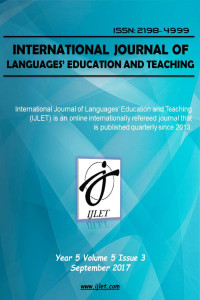Öz
The aim of the study is to assess the fluency problems observed in the speech of middle school students in terms of species. The study group consists of the sixth, seventh and eighth grade students in the Ticaret Borsası Secondary School located in the province of Bayraklı in İzmir. Power analysis was done for the sample and the sample was determined as 60 students. Each student participating in the study read the texts in the textbooks that correspond to the class levels and then the voice recordings of the students were taken while the texts were told by the students. Speech samples composed of at least 300 words from recorded speech samples were converted to transcription. The data obtained from the records were analyzed for the purpose of the study and statistically analyzed. As a result of the study, the most common types of fluency problems observed in students' speech were "filled gaps", “filled words", “repetitions", "hesitations", “prolongations” and at least “false starts".
Anahtar Kelimeler
Speech types of disfluency in speech secondary school students
Kaynakça
- Akgün, Ö. (2005). Türkçe konuşan 3-6 yaş grubundaki kekemeliği olan ve olmayan çocukların konuşma akıcısızlıklarının incelenmesi. Yayınlanmamış Yüksek Lisans Tezi, Anadolu Üniversitesi, Eskişehir.
- Altıparmak, A. (2015). Türkçe konuşmada akıcısızlık: psikodilbilimsel bir inceleme. Doktora Tezi, Dokuz Eylül Üniversitesi, İzmir.
- Bjerkan, B.(1980). Word fragmentations and repetitions ın the spontaneous speech of 2-6-yr- old children. Journal of Fluency Disorders, v.5. p.137-148. 1980.
- Carlo, E.J., Watson, J.B.(2003). Disfluencies of 3-and-5-year -old spanish-speaking children. Journal of Fluency Disorders, v.28. p.37-53.
- Carter,R., McCarthy, M. (2006). Cambridge grammer of English acomprehensive guide. Cambridge University press, Cambridge.
- DeJoy, D.A., Gregory, H.H.(1985). The relationship between age and frequency of disfluency in preschool children. Journal of Fluency Disorders, v.10. p.107-122. 1985.
- Doğan, Ö. (2001). Okulöncesi dönem çocuklarının konuşmalarının akıcılık özelliklerinin incelenmesi. Yayınlanmamış Doktora Tezi, Hacettepe Üniversitesi, Ankara.
- Geetha, Y.V., Pratibha, K., Ashok, R. (2000). Classification of childhood disfluencies using neural networks. Journal of Fluency Disorders, v.25:99-117. 2000.
- Karasar, N. (2012). Bilimsel araştırma yöntemi. Ankara: Nobel Yayınları.
- Liu, Y., Shriberg, E. ve Stolcke, A. (2003). Automatic disfluency ıdentification in conversational speech using multiple knowledge sources. In Proceedings of the European Conference on Speech Communication and Technology,957-960.
- Maclay, H., Osgood C.H.(1959). Hesitation phenomena in spontaneous English speech. Source Word, Volume 15, p.19-44.
- Menyhárt, K. (2003). Age-dependent types and frequency of disfluencies. In Proceedings of DiSS’03(pp.45-48),Göteborg University, Sweeden.
- Pellowski, M.W., Conture, E.G.(2002). Characteristics of speech disfluency and stuttering behaviors in 3-and 4-year-old children. Journal of Speech, Language and Hearing Research, v.45. p.30-34. 2002.
- Ruhi, Ş. (2011). Creating a sustainable large corpus of spoken turkish for multiple research purposes. Ulusal Konuşma ve Dil Teknolojileri Platformu Kuruluşu: Türkçede Mevcut Durum Çalıştay Bildirileri, TÜBİTAK, BİLGEM, Gebze.
Öz
Çalışmanın amacı, ortaokul öğrencilerinin konuşmalarında gözlemlenen akıcılık sorunlarını türlerini “dolu duraklar”, “tekrarlar”, “dolgu sözcükler”, “tereddütler”, “yanlış başlangıçlar”, “uzatmalar” açısından öğrencilerin sınıf düzeylerine göre değerlendirmektir. Çalışma grubu, İzmir ili Bayraklı ilçesinde bulunan Ticaret Borsası Ortaokulundaki altıncı, yedinci ve sekizinci sınıf öğrencilerinden oluşmaktadır. Örneklem için güç analizi yapılmıştır ve örneklem 60 öğrenci olarak belirlenmiştir. Çalışmaya katılan öğrencilerin her birine ders kitaplarında yer alan, sınıf düzeylerine uygun metinler okunmuş ve ardından metinler öğrenciler tarafından anlatılırken öğrencilerin ses kayıtları alınmıştır. Kaydedilen konuşma örneklerinden en az 300 sözcükten oluşan konuşma örnekleri çevriyazıya dönüştürülmüştür. Kayıtlardan elde edilen veriler çalışmanın amacı doğrultusunda incelenmiş ve istatistiksel olarak analiz edilmiştir. Çalışmanın sonucunda öğrencilerin konuşmalarında gözlemlenen akıcılık sorunu türlerinden en yaygın olarak “dolu duraklar”, daha sonra “tekrarlar”, “dolgu sözcükler”, “tereddütler”, “yanlış başlangıçlar”, en az ise “uzatmalar” görülmüştür.
Anahtar Kelimeler
Konuşma konuşmada akıcılık sorunu türleri ortaokul öğrencileri
Kaynakça
- Akgün, Ö. (2005). Türkçe konuşan 3-6 yaş grubundaki kekemeliği olan ve olmayan çocukların konuşma akıcısızlıklarının incelenmesi. Yayınlanmamış Yüksek Lisans Tezi, Anadolu Üniversitesi, Eskişehir.
- Altıparmak, A. (2015). Türkçe konuşmada akıcısızlık: psikodilbilimsel bir inceleme. Doktora Tezi, Dokuz Eylül Üniversitesi, İzmir.
- Bjerkan, B.(1980). Word fragmentations and repetitions ın the spontaneous speech of 2-6-yr- old children. Journal of Fluency Disorders, v.5. p.137-148. 1980.
- Carlo, E.J., Watson, J.B.(2003). Disfluencies of 3-and-5-year -old spanish-speaking children. Journal of Fluency Disorders, v.28. p.37-53.
- Carter,R., McCarthy, M. (2006). Cambridge grammer of English acomprehensive guide. Cambridge University press, Cambridge.
- DeJoy, D.A., Gregory, H.H.(1985). The relationship between age and frequency of disfluency in preschool children. Journal of Fluency Disorders, v.10. p.107-122. 1985.
- Doğan, Ö. (2001). Okulöncesi dönem çocuklarının konuşmalarının akıcılık özelliklerinin incelenmesi. Yayınlanmamış Doktora Tezi, Hacettepe Üniversitesi, Ankara.
- Geetha, Y.V., Pratibha, K., Ashok, R. (2000). Classification of childhood disfluencies using neural networks. Journal of Fluency Disorders, v.25:99-117. 2000.
- Karasar, N. (2012). Bilimsel araştırma yöntemi. Ankara: Nobel Yayınları.
- Liu, Y., Shriberg, E. ve Stolcke, A. (2003). Automatic disfluency ıdentification in conversational speech using multiple knowledge sources. In Proceedings of the European Conference on Speech Communication and Technology,957-960.
- Maclay, H., Osgood C.H.(1959). Hesitation phenomena in spontaneous English speech. Source Word, Volume 15, p.19-44.
- Menyhárt, K. (2003). Age-dependent types and frequency of disfluencies. In Proceedings of DiSS’03(pp.45-48),Göteborg University, Sweeden.
- Pellowski, M.W., Conture, E.G.(2002). Characteristics of speech disfluency and stuttering behaviors in 3-and 4-year-old children. Journal of Speech, Language and Hearing Research, v.45. p.30-34. 2002.
- Ruhi, Ş. (2011). Creating a sustainable large corpus of spoken turkish for multiple research purposes. Ulusal Konuşma ve Dil Teknolojileri Platformu Kuruluşu: Türkçede Mevcut Durum Çalıştay Bildirileri, TÜBİTAK, BİLGEM, Gebze.
Ayrıntılar
| Birincil Dil | Türkçe |
|---|---|
| Konular | Türkçe Eğitimi |
| Bölüm | Araştırma Makalesi |
| Yazarlar | |
| Yayımlanma Tarihi | 30 Eylül 2017 |
| Yayımlandığı Sayı | Yıl 2017 Cilt: 5 Sayı: 3 |


